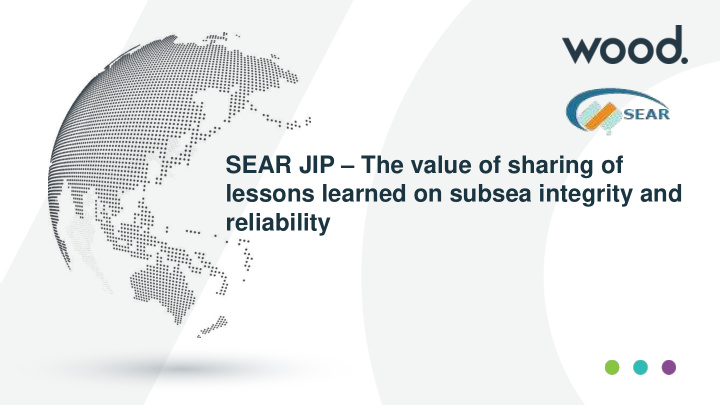



SEAR JIP – The value of sharing of lessons learned on subsea integrity and reliability
Agenda 1 – Overview 2 – Challenges 3 – SEAR Reliability Database 4 – SEAR Testing Program 5 – Outlook 2
Overview 6 Operators participating on Phase V of the SEAR JIP: Goal : Reduce subsea equipment failures through collaboration and knowledge sharing. 3
Overview – The Environment The Environment: • High sea water temperatures • High nutrient environment • High currents • Cyclones 4
Overview – Intervention Issues 5
SEAR Reliability Database Vision: Low cost / high value method of capturing, sharing failures and lessons learnt for Australia. • Collection of asset and failure information – Anonymization of results • Reliability Dashboard – Presentation of reliability data to permit comparison with other industry data sources (i.e. OREDA) • Lessons Learned information incorporated into the SEAR Database 6
SEAR Testing Program Problem: Unwanted marine fouling in subsea structures: significant interventions cost Significant 2 fold No industry Poorly challenge: problem for understood guidelines on marine all SEV and how to design how to growth and operators in for warm design-out calcareous Northern waters mechanisms deposit Australian No industry Anti-fouling Subsea Test High best practice coatings used Structure to Intervention on how to test full scale elsewhere Cost to remediate equipment perform Remediate marine inadequately performance the Problem fouling here 7
SEAR Testing Program - STS Delivery Roadmap • Transforming Australia Subsea Equipment Reliability (TASER) Subset of the SEAR JIP • Collaborative industry effort, across operators, universities and suppliers, to address the root causes of marine fouling challenges. • Testing Program will deploy game changing technology in ‘living laboratories’ . 2016 2017 2018 2019 2021 2020 Vendor Select STS Inspection/ STS STS Inspection Engagement Technology STS Inspection Retrieval Deployment (EOI) Vendors Establish Data Collection/ contract with STS Inspection Assessment Vendors STS Design & Issue Industry Fabrication Best Practice 8 *TASER – funds awarded by NERA
SEAR Testing Program Suppliers collaborating with the Test Program: Vision : • Lessons learned on the testing program will be shared back to vendors, enabling equipment reliability issues to be designed out. • Over 100 samples loaned to be tested on STS. • STS will be underwater for at least 3 years. • Issue Best Practice Guideline on Marine Fouling 9
SEAR Testing Program Problem: Unwanted gas in controls systems; a source of loss of insulation resistance? Gas presence Poorly Poorly Significant High thought to be understood understood problem for Intervention the cause of long term all SEV and mechanisms Cost to electrical effects of gas and origins operators in Remediate termination presence on of gas Northern the Problem failures performance evolution Australian Umbilical Test Program Roadmap 2018 2019 Issue RFP to Research Institutions Test Program Desk top analysis to determine the possible cause(s) Perform cost effective tests to verify the 10 of gassing and fluid migration in subsea controls plausible cause(s) of subsea umbilical cable gassing, umbilicals fluid ingress and migration and performance impact
Outlook • COLLABORATIVE effort across large group of Australian Subsea System Operators. • COLLECTION of reliability data for Australian operations. • Marine Fouling Mitigation and Remediation: Findings will be consolidated into INDUSTRY BEST PRACTICE GUIDELINE . • Umbilical Performance Test: Findings will allow DESIGN-OUT gas migration challenge. 11
For additional information please contact: searjip@woodplc.com or www.searjip.com 12
Recommend
More recommend